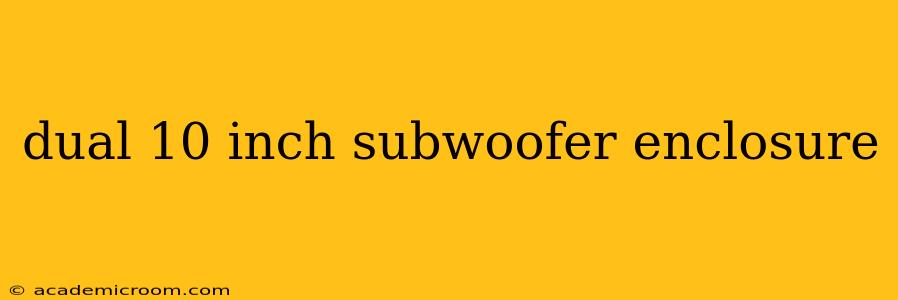Building a dual 10-inch subwoofer enclosure can significantly enhance your car audio or home theater system's low-frequency response. This guide delves into the crucial aspects of designing, constructing, and optimizing such an enclosure for superior sound quality. We'll explore different enclosure types, port designs, and materials, addressing common questions and concerns.
What are the Different Types of Dual 10-Inch Subwoofer Enclosures?
The type of enclosure you choose dramatically impacts the sound characteristics of your subwoofer. The most common types are:
-
Sealed (Acoustic Suspension): These enclosures are airtight, offering tight, accurate bass with minimal distortion. They're generally smaller than ported enclosures but produce less overall output. Ideal for smaller spaces or situations where accuracy is prioritized over sheer volume.
-
Ported (Bass Reflex): Ported enclosures use a port (tube) to augment the subwoofer's output, extending the low-frequency response. They produce louder bass than sealed enclosures but may introduce some port noise or chuffing if not designed correctly. Excellent for maximizing output in larger spaces.
-
Bandpass: These enclosures are more complex, utilizing multiple chambers and ports to create specific frequency response characteristics. They offer very high output in a narrow frequency range, but can be challenging to design and build correctly. Generally not recommended for beginners.
-
Horn: Horn enclosures use a progressively expanding horn-shaped structure to load the subwoofer, providing exceptionally high output and efficiency. These are often very large and complex, typically used in professional sound systems.
What Size Port Do I Need for My Dual 10-Inch Subwoofer Enclosure?
The port size and length are critical for achieving optimal performance in a ported enclosure. Incorrect port dimensions can lead to port noise, reduced output, or uneven frequency response. There are several online calculators and software programs that can help you determine the ideal port size and length based on your specific subwoofer parameters (e.g., Thiele/Small parameters). These parameters are usually found in the subwoofer's specifications. Crucially, always double-check your calculations before cutting your port.
What Material Should I Use for My Dual 10-Inch Subwoofer Enclosure?
The choice of material affects the enclosure's rigidity and sound dampening capabilities. Popular options include:
-
Medium-Density Fiberboard (MDF): MDF is the most common choice due to its density, affordability, and ease of working with. It offers good rigidity and minimizes unwanted resonances.
-
Particle Board: Less expensive than MDF but less rigid and more prone to resonance. Not recommended for high-output systems.
-
Plywood: Plywood can be strong and rigid, but it can be more challenging to work with and may be more expensive than MDF.
Regardless of the chosen material, internal bracing is highly recommended to increase rigidity and reduce unwanted vibrations.
How Much Internal Bracing Do I Need?
Internal bracing significantly improves the enclosure's structural integrity, reducing unwanted vibrations and enhancing sound quality. For a dual 10-inch enclosure, a robust bracing system is crucial. Consider using strategically placed supports, creating a framework to stiffen the structure.
What is the Best Placement for a Dual 10-Inch Subwoofer Enclosure?
Placement influences the perceived bass response. Experimentation is key. In a car audio system, consider placing the enclosure in a location where it minimizes unwanted resonances and maximizes the bass distribution within the vehicle. In a home theater setup, corner placement often enhances bass response due to the boundary-reinforcement effect.
How Much Power Can a Dual 10-Inch Subwoofer Enclosure Handle?
The power handling capability of your enclosure is limited by the subwoofers and the materials used in construction. Exceeding the subwoofers' power handling can lead to damage. Always ensure your amplifier is appropriately matched to the subwoofer's specifications.
Can I Build My Own Dual 10-Inch Subwoofer Enclosure?
Yes, with the right tools, plans, and knowledge, building your own enclosure is feasible. However, meticulous planning and precise execution are crucial for optimal results. Start with detailed plans, ensuring accurate measurements and calculations. If you're unsure, seek guidance from experienced builders or consult online resources.
This guide provides a solid foundation for your dual 10-inch subwoofer enclosure project. Remember, careful planning, precise construction, and thorough testing are essential for achieving a high-quality listening experience.
